Overview
- Brief Narrative
- British Airborne paratrooper's Denison jacket with a camouflage pattern worn by 22 year old Manfred Gans, a Jewish refugee from Germany, while serving as a Marine Commando for the British Army from May 1944 to May 1945. The Denison smock was designed with an adjustable tail flap, and worn over standard battle dress to keep gear secured when a paratrooper deployed his parachute. In January 1933, Adolf Hitler became the chancellor of Germany and implemented anti-Jewish laws. In July 1938, Manfred went to England. On September 3, 1939, Great Britain declared war against Germany, and Manfred was classified as an enemy alien. In spring 1940, Germany invaded Western Europe. Manfred was arrested and sent to an internment camp on the Isle of Man. Manfred enlisted in the British Army, where he spent two years assigned to a labor unit. At the end of 1942, he was recruited for his language skills and served as a member of a Special Forces troop composed of fluent German speaking refugees. Each man in the unit was assigned a British alias: Manfred's was Fred Gray. On June 6, 1944, he participated in the invasion of Normandy. It was his mission to go out on every patrol and troop action and infiltrate German positions to convince soldiers to surrender, and to interrogate prisoners and gather intelligence as his unit advanced through France, Belgium, and northern Germany. Manfred learned from an American uncle that his parents had been imprisoned in Theresienstadt labor camp-ghetto in German occupied Czechoslovakia. In early May 1945, he drove across Germany, through enemy lines, to find his parents. He was reunited with them in Theresienstadt on May 11. His parents returned to the Netherlands in July. Manfred was demobilized in August 1945. He married Anita Lamm in 1948. She had fled Germany with her parents in 1938, assisted by Manfred's parents. He joined her in the US in 1950.
- Date
-
manufacture:
1944
use: 1944-1945
- Geography
-
manufacture:
Great Britain
- Credit Line
- United States Holocaust Memorial Museum Collection, Gift of Daniel Gans and Aviva Gans-Rosenberg
- Markings
- front, snaps, underside, engraved : NEWEY PAT. 201430-22
front, zipper pull, both sides, engraved : TALON
front, left interior, fabric tag, printed, black ink : SMOCK - DENISON / (AIRBORNE TROOPS) / SIZE No. 2 / Height5 5’ 3” to 5’ 5” / Breast …. 37” to 39” / JOHN GORDON & CO. / 1944 / upward pointing arrow - Contributor
-
Subject:
Manfred Gans
Issuer: British Airborne Forces
Manufacturer: John Gordon & Co.
- Biography
-
Manfred Gans was born on April 27, 1922, in Borken, Germany, to Moritz and Else Fraenkel Gans. His family had been in Borken for over 300 years. Moritz was born on July 7, 1885. He was a German Army veteran who had lost a lung and a leg in Italy during World War I. Moritz was the only Jew ever elected to the city council. Else was born on September 1, 1891, in Volksen, Germany. In 1924, Moritz and Else established a prosperous textile manufacturing business. Manfred’s older brother, Karl, was born on May 23, 1920, and his younger brother, Theodor (Theo), was born on May 1, 1925. The brothers were raised Orthodox. They attended the Jewish elementary school and a Catholic high school.
In January 1933, Adolf Hitler became the chancellor of Germany. Manfred and his brothers spent that summer at their Aunt and Uncle’s hachshara farm in Gut Neuendorf. While there, Manfred met Anita Lamm, the daughter of his father’s best friend. Anita was born on August 31, 1923, in Berlin, to Leo and Margaret Lamm. In 1935, as government persecution of Jews increased, Moritz began moving his money out of the country. In 1936, Karl immigrated to Palestine. In spring 1938, Moritz helped the Lamm family immigrate secretly to the United States. After they left, Anita and Manfred began writing to each other.
In July 1938, Manfred went to England and stayed with a Jewish family, the Jacobs. He was supposed to return home in the fall, but his parents told him to stay. With the help of the German Jewish Aide Committee, Manfred relocated to Manchester and found work in a factory’s repair shop. Manfred wanted to continue his Orthodox lifestyle, so Mr. Jacobs introduced him to a Jewish family in Manchester, the Steinharts. They suggested that he stay at a relative’s boarding house, and often invited him to partake in religious activities and socialize with their community. After the November 9 - 10, 1938, Kristallnacht pogrom in Germany, Moritz and Else sent Theo out of the country to a boarding school in Kent, England.
In August 1939, Moritz and Else left Germany as advised by a family friend who was the head of the Gestapo in Borken. They settled in Zandvoort, Netherlands. On September 1, Germany invaded Poland, and two days later, Great Britain declared war. Manfred, as a German refugee, was labeled an enemy alien. He had to register with the government and go before a tribunal to evaluate his level of risk to the nation’s security. He was classified as level C or no risk. In spring 1940, Germany invaded Western Europe. In early summer, Manfred was arrested for being an enemy alien and sent to an internment camp in Bury and then Shrewsbury. In September, he was shipped to a camp on the Isle of Man. In December, the British government lowered the enlistment age for enemy aliens to eighteen and Manfred enrolled in the army. He was assigned to the Pioneer Corps, an unarmed labor unit. In 1941, Manfred stopped receiving letters from his parents.
At the end of 1942, Manfred was interviewed and selected for a special assignment. He was transferred to Aberdovey, Wales, to train as a member of a Special Forces unit: the Three Troop of the Tenth Inter-Allied Commando. The unit consisted of fluent German speakers, most of them Jewish refugees. Everyone in the troop had to leave behind their life and assume a new non-Jewish identity: Manfred’s Welsh alias was Fred Gray. The troop went through a year of rigorous training in military tactics and intelligence, as well as physical conditioning. In May 1944, Manfred was assigned to the 41st Royal Marine Commando. He was briefed about the planned invasion of Normandy, and landed on the French coast with the unit on June 6. Manfred went out on every patrol and attack, and his mission was to infiltrate German lines and convince the soldiers to surrender. He helped his unit capture German positions, interrogate prisoners, and gather intelligence in the field as they advanced through France and Belgium. In late 1944, Manfred received a field promotion to officer.
Manfred’s unit was assigned to northern Germany, and on April 1, 1945, he arrived in Borken. He found his parents’ house still standing, and learned that it had been used as a Gestapo headquarters; the wine cellar as a torture chamber. Manfred’s American uncle wrote to tell him that, in 1941, his parents had gone into hiding in Leeuwarden, Netherlands. In 1943, they were betrayed, and transported to Westerbork transit camp and then deported to Theresienstadt labor camp-ghetto in German occupied Czechoslovakia. He did not know if they were still alive, but by early May, he requested permission to take a jeep and a driver to Terezin to find out. Germany surrendered on May 7, 1945. Manfred arrived on May 11, two days after the Soviets liberated the camp. A registration clerk told him that his parents were still alive. He found them and they talked all night. Manfred had to leave the next day to return to his unit. The roads were still dangerous to travel, and the camp was in quarantine, so his parents stayed behind at the camp. Manfred did take many letters from other inmates, including one from a former judge at The Hague, addressed to Princess Juliana. His delivery of the letter led to the repatriation of his parents and other Dutch prisoners, back to the Netherlands.
Manfred received a field promotion to captain. He served as the Deputy Commander of the Intelligence Section at Sennelager, a prisoner of war camp for high ranking Nazis being questioned and prepared for war crimes trials. In July, his parents returned to the Netherlands. In August 1945, Manfred was demobilized, returned to England, and became a British citizen. In 1948, Manfred travelled to New York and married Anita Lamm, who had written to him throughout the war under the name Joan Gary. In August 1950, Manfred immigrated to the United States. The couple had two children. In the 1950s, his parents, Moritz and Else, and brother, Theo, all immigrated to Israel, joining Karl, now named Gershon Kadar, who had served in the Jewish Brigade during the war. Anita, age 67, died in January 1991. Manfred, age 88, died on September 12, 2010, in Fort Lee, New Jersey.
Physical Details
- Language
- English
- Classification
-
Clothing and Dress
- Category
-
Military uniforms
- Object Type
-
Blouses (military jackets) (aat)
- Physical Description
- Durable, long-sleeved hip length green cotton denim paratrooper's jacket with light and dark brown and dark green brushstroke camouflage. It has a reinforced high stand collar, a full-length metal zipper, and shoulder epaulets: the left has a brown plastic button, the right button is missing. There are 4 large patch pockets with envelope flaps and brass-colored metal snap closures on both sides of the zipper. The cuffs are padded and trimmed with black leather. Each cuff has an adjustable cuff tab with 1 button hole, and 2 buttons. There is an adjustable waist tab with 1 snap cap and 2 studs on each side. Between the lower pocket and zipper on each side is a column of 3 metal snap caps. Sewn to the back, center, inner hem of the bottom is a tapered flap, approximately 12 inches long and 2 ½ inches wide, with 2 snap studs at the end. The flap is an adjustable strap, either worn between the legs and fastened to the snap columns on the front, or folded up and attached to 2 back snaps. There is an additional 10 inch cloth panel attached inside on the upper and lower back sections. The underarms have cloth inserts with 6 eyelet vents to expand the range of motion. There is a stamp and a manufacturer's label on the inside left pocket. A long sleeve brown cloth liner has been tacked inside at the collar and cuffs; it is a postwar addition. The jacket was worn by family members after the war. It has been heavily used and has many repairs, patches, tears, and missing portions.
- Dimensions
- overall: Height: 33.000 inches (83.82 cm) | Width: 19.000 inches (48.26 cm)
- Materials
- overall : cloth, thread, metal, plastic, leather
- Inscription
- front, interior, near tag, stamped, black ink : W[?] / M / D[?] /↑
Rights & Restrictions
- Conditions on Access
- No restrictions on access
- Conditions on Use
- No restrictions on use
Keywords & Subjects
- Topical Term
- Jewish refugees--Great Britain--Biography. Jewish soldiers--Great Britain--Biography. Jews--Germany--Borken (North Rhine-Westphalia)--Biography. Soldiers--Great Britain--Biography. World War, 1939-1945--Commando operations--Great Britain--Personal narratives. World War, 1939-1945--Personal narratives, Jewish.
- Corporate Name
- Great Britain. Royal Marines. Commando, 41
Administrative Notes
- Legal Status
- Permanent Collection
- Provenance
- The jacket was donated to the United States Holocaust Memorial Museum in 2013 by Daniel Gans, the son of Manfred Gans.
- Funding Note
- The cataloging of this artifact has been supported by a grant from the Conference on Jewish Material Claims Against Germany.
- Record last modified:
- 2023-08-25 09:21:48
- This page:
- https://collections.ushmm.org/search/catalog/irn84572
Download & Licensing
In-Person Research
- By Appointment
- Request 21 Days in Advance of Visit
- Plan a Research Visit
- Request to See This Object
Contact Us
Also in Manfred and Anita Lamm Gans family collection
The collection consists of a military jacket, scrip, correspondence, documents, and photographs relating to the experiences of Manfred Gans in Germany, Great Britain, the British Army, and the United States before, during, and after the Holocaust, his family in Germany, the Netherlands, Great Britain, Palestine, and Theresienstadt ghetto labor camp before, during, and after the Holocaust, and Anita Lamm and her family in Germany and the United States during and after the Holocaust.
Date: after 1905-before 1983
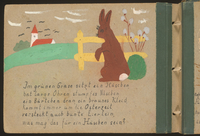
Gans family papers
Document
The collection relates to the Gans family, originally of Borken, Germany. It includes photographs of pre-war life, including a photograph album depicting a day in the life of the three Gans boys. The majority of the collection consists of correspondence, mainly from Anita Lamm in the United States to Manfred Gans, then a member of the British military. Also includes documentation and correspondence related to the wartime experiences of Moritz and Else Gans, who were deported to Westerbork and Bergen-Belsen, and liberated from Theresienstadt. Includes Moritz’s diary, into which he made short entries throughout his internment experiences, ending when Manfred, as a member of the British military, found his parents in Theresienstadt. Additionally, there is a memoir by Manfred entitled “Life Gave Me a Chance.” The memoir describes his childhood in Borken, his departure for England for school in 1938, his internment on the Isle of Man as an enemy alien, his participation in the British Army as an interpreter and intelligence operative (including participation in the D-Day invasion), his trip to Theresienstadt in an attempt to locate his parents, and his post-war life.
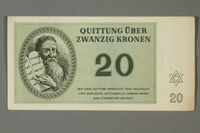
Theresienstadt ghetto-labor camp scrip, 20 kronen note, acquired by a German Jewish refugee in the British army
Object
Scrip, valued at 20 kronen, distributed in Theresienstadt (Terezin) ghetto-labor camp, acquired by Manfred Gans, a German Jewish refugee who served as a Marine Commando for the British Army from May 1944 to May 1945. The scrip was issued in the camp his parents had been deported to in 1943 and he placed this note into his Soldier’s Book. In 1938, to escape Nazi-controlled Germany, Manfred immigrated to England. After Great Britain declared war against Germany on September 3, 1939, he was classified as an enemy alien, arrested, and sent to an internment camp on the Isle of Man. Manfred later enlisted in the British Army, where he spent two years assigned to a labor unit before being recruited for a Special Forces troop, which landed at Normandy on June 6, 1944. As his unit advanced through France, Belgium, and northern Germany, it was Manfred’s mission to infiltrate German positions to convince soldiers to surrender, interrogate prisoners, and gather intelligence. Manfred learned from his uncle that his parents had been imprisoned in Theresienstadt ghetto-labor camp in German-occupied Czechoslovakia, but he did not know if they were still alive. He drove across enemy lines to find out, and learned they had survived. They were reunited in Theresienstadt on May 11, 1945. His parents returned to the Netherlands in July and he was demobilized in August. Manfred married Anita Lamm in 1948 and moved to the United States in 1950.
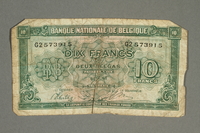
Belgium, 10 francs or 2 belga note, acquired by a German Jewish refugee in the British army
Object
Bank note, valued at 10 francs, acquired by Manfred Gans, a German-Jewish refugee who served as a Marine Commando for the British Army from May 1944 to May 1945. Manfred’s troop served in Belgium during the fall of 1944 and he placed this note into his Soldier’s Book. The note was a special issue distributed by the National Bank of Belgium after allied forces liberated the country from German occupation in 1944. In 1938, to escape Nazi-controlled Germany, Manfred immigrated to England. After Great Britain declared war against Germany on September 3, 1939, he was classified as an enemy alien, arrested, and sent to an internment camp on the Isle of Man. Manfred later enlisted in the British Army, where he spent two years assigned to a labor unit before being recruited for a Special Forces troop, which landed at Normandy on June 6, 1944. As his unit advanced through France, Belgium, and northern Germany, it was Manfred’s mission to infiltrate German positions to convince soldiers to surrender, interrogate prisoners, and gather intelligence. Manfred learned from his uncle that his parents had been imprisoned in Theresienstadt ghetto-labor camp in German-occupied Czechoslovakia, but he did not know if they were still alive. He drove across enemy lines to find out, and learned they had survived. They were reunited in Theresienstadt on May 11, 1945. His parents returned to the Netherlands in July and he was demobilized in August. Manfred married Anita Lamm in 1948 and moved to the United States in 1950.
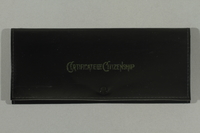
Certificate of Citizenship document case belonging to a German Jewish refugee couple
Object
“Certificate of Citizenship” document case owned by Anita Lamm and Manfred Gans, German-Jewish refugees who became United States citizens in 1945 and 1955. In 1938, to escape Nazi-controlled Germany, Manfred’s father helped Anita and her parents immigrate to the United States, and Manfred immigrated to England. After Great Britain declared war against Germany on September 3, 1939, he was classified as an enemy alien, arrested, and sent to an internment camp on the Isle of Man. Manfred later enlisted in the British Army, where he spent two years assigned to a labor unit before being recruited for a Special Forces troop, which landed at Normandy on June 6, 1944. As his unit advanced through France, Belgium, and northern Germany, it was Manfred’s mission to infiltrate German positions to convince soldiers to surrender, interrogate prisoners, and gather intelligence. Manfred learned from his uncle that his parents had been imprisoned in Theresienstadt ghetto-labor camp in German-occupied Czechoslovakia, but he did not know if they were still alive. He drove across enemy lines to find out, and learned they had survived. They were reunited in Theresienstadt on May 11, 1945. His parents returned to the Netherlands in July and he was demobilized in August. Manfred married Anita in 1948 and moved to the United States in 1950.
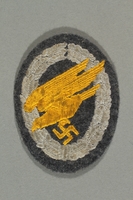
Luftwaffe paratrooper badge with a yellow eagle acquired by a German Jewish refugee in the British army
Object
Luftwaffe (German Air Force) paratrooper badge, acquired by Manfred Gans, a German Jewish refugee who served as a Marine Commando for the British Army from May 1944 to May 1945. This type of patch was issued to German paratroopers who had successfully completed six jumps. Gans took the badge from a prisoner who claimed to have been the driver for Erwin Rommel during his command of the German forces in North Africa from 1941-1943. He sent the badge in a letter dated 27 October 1944 to his friend, Anita Lamm, who had immigrated to the United States. For Anita, the badge symbolized hope for victory and the end of the war. In 1940, Manfred enlisted in the British Army, where he spent two years assigned to a labor unit before being recruited for a Special Forces troop, which landed at Normandy on June 6, 1944. As his unit advanced through France, Belgium, and northern Germany, it was Manfred’s mission to infiltrate German positions to convince soldiers to surrender, interrogate prisoners, and gather intelligence. Manfred learned from his uncle that his parents had been imprisoned in Theresienstadt ghetto-labor camp in German-occupied Czechoslovakia, but he did not know if they were still alive. He drove across enemy lines to find out, and learned they had survived. They were reunited in Theresienstadt on May 11, 1945. His parents returned to the Netherlands in July and he was demobilized in August. Manfred married Anita in 1948 and moved to the United States in 1950.
Manfred and Anita Lamm Gans family collection
Document
Correspondence between Manfred and Anita Gans.



